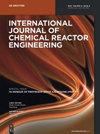Optimized infrared-assisted extraction to obtain total lipid from microalgae Scenedesmus obliquus: a green approach
IF 1.6
4区 工程技术
Q3 Chemical Engineering
International Journal of Chemical Reactor Engineering
Pub Date : 2023-03-03
DOI:10.1515/ijcre-2022-0107
引用次数: 0
Abstract
Abstract Microalgae oil has great potential to address the growing energy demand and dependence on fossil fuels. However, the multilayered cell walls of microalgae hinder efficient extraction and enhanced lipid recovery. In this study, we develop a novel protocol based on near infrared-assisted extraction (NIRAE) technology to extract efficiently total lipids from Scenedesmus obliquus. Under a greener solvent extraction approach, the effect of nine non-polar/polar solvent systems in various ratios on lipid yield was tested, and the results were compared with Soxhlet, Folch, and Bligh–Dyer methods. The highest oil yields were NIRAE 15.43%, and Soxhlet 22.24%, using AcoEt/MeOH (1:2 v/v). For Folch and Bligh–Dyer, 9.11 and 10%, respectively. The optimized NIRAE conditions obtained using response surface methodology (RSM): 43.8 min, solvent/biomass 129.90:1 (m/v), and AcOEt/MeOH 0.57:2.43 (v/v) increased the oil yield significantly to 24.20%. In contrast to conventional methods, the overall optimized NIRAE process satisfied the requirements of a green extraction because of the simple and safe operation, less solvent toxicity, lower extraction time, and solvent and energy consumption.优化红外辅助提取微藻中总脂质:绿色方法
微藻油在解决日益增长的能源需求和对化石燃料的依赖方面具有巨大的潜力。然而,微藻的多层细胞壁阻碍了高效提取和提高脂质回收率。在这项研究中,我们开发了一种基于近红外辅助提取(NIRAE)技术的新方案,以有效地提取斜状Scenedesmus obliquus的总脂肪。在绿色溶剂萃取方法下,测试了9种不同比例的非极性/极性溶剂体系对脂质收率的影响,并将结果与Soxhlet、Folch和Bligh-Dyer方法进行了比较。在AcoEt/MeOH (1:2 v/v)条件下,NIRAE和Soxhlet的产油率分别为15.43%和22.24%。Folch和Bligh-Dyer分别为9.11和10%。采用响应面法(RSM)优化得到的NIRAE条件为:43.8 min,溶剂/生物质129.90:1 (m/v), AcOEt/MeOH 0.57:2.43 (v/v),可显著提高原油收率至24.20%。与传统提取方法相比,优化后的NIRAE工艺操作简单安全,溶剂毒性小,提取时间短,溶剂和能源消耗少,满足绿色提取的要求。
本文章由计算机程序翻译,如有差异,请以英文原文为准。
求助全文
约1分钟内获得全文
求助全文
来源期刊
CiteScore
2.80
自引率
12.50%
发文量
107
审稿时长
3 months
期刊介绍:
The International Journal of Chemical Reactor Engineering covers the broad fields of theoretical and applied reactor engineering. The IJCRE covers topics drawn from the substantial areas of overlap between catalysis, reaction and reactor engineering. The journal is presently edited by Hugo de Lasa and Charles Xu, counting with an impressive list of Editorial Board leading specialists in chemical reactor engineering. Authors include notable international professors and R&D industry leaders.

 求助内容:
求助内容: 应助结果提醒方式:
应助结果提醒方式:


